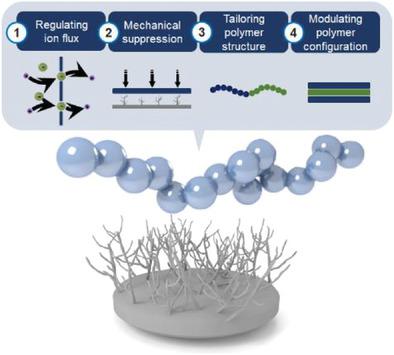当前位置:
X-MOL 学术
›
Macromol. Rapid Commun.
›
论文详情
Our official English website, www.x-mol.net, welcomes your
feedback! (Note: you will need to create a separate account there.)
Dendrite-Suppressing Polymer Materials for Safe Rechargeable Metal Battery Applications: From the Electro-Chemo-Mechanical Viewpoint of Macromolecular Design
Macromolecular Rapid Communications ( IF 4.2 ) Pub Date : 2021-07-03 , DOI: 10.1002/marc.202100279 Da-Sol Kwon 1 , Hee Joong Kim 2 , Jimin Shim 1
Macromolecular Rapid Communications ( IF 4.2 ) Pub Date : 2021-07-03 , DOI: 10.1002/marc.202100279 Da-Sol Kwon 1 , Hee Joong Kim 2 , Jimin Shim 1
Affiliation

|
Metal batteries have been emerging as next-generation battery systems by virtue of ultrahigh theoretical specific capacities and low reduction potentials of metallic anodes. However, significant concerns regarding the uncontrolled metallic dendrite growth accompanied by safety hazards and short lifespan have impeded practical applications of metal batteries. Although a great deal of effort has been pursued to highlight the thermodynamic origin of dendrite growth and a variety of experimental methodologies for dendrite suppression, the roles of polymer materials in suppressing the dendrite growth have been underestimated. This review aims to give a state-of-the-art overview of contemporary dendrite-suppressing polymer materials from the electro-chemo-mechanical viewpoint of macromolecular design, including i) homogeneous distribution of metal ion flux, ii) mechanical blocking of metal dendrites, iii) tailoring polymer structures, and iv) modulating the physical configuration of polymer membranes. Judiciously tailoring electro-chemo-mechanical properties of polymer materials provides virtually unlimited opportunities to afford safe and high-performance metal battery systems by resolving problematic dendrite issues. Transforming these rational design strategies into building dendrite-suppressing polymer materials and exploiting them towards polymer electrolytes, separators, and coating materials hold the key to realizing safe, dendrite-free, and long-lasting metal battery systems.
中文翻译:

用于安全可充电金属电池应用的枝晶抑制聚合物材料:从高分子设计的电化学机械观点
金属电池凭借超高的理论比容量和金属负极的低还原电位,已成为下一代电池系统。然而,对伴随安全隐患和短寿命的不受控制的金属枝晶生长的严重担忧阻碍了金属电池的实际应用。尽管已经进行了大量努力来强调枝晶生长的热力学起源和各种抑制枝晶的实验方法,但聚合物材料在抑制枝晶生长方面的作用被低估了。本综述旨在从高分子设计的电化学机械角度对当代抑制枝晶的聚合物材料进行最先进的概述,包括 i) 金属离子通量的均匀分布,ii) 金属枝晶的机械阻塞,iii) 调整聚合物结构,以及 iv) 调节聚合物膜的物理构型。明智地调整聚合物材料的电化学机械性能,通过解决有问题的枝晶问题,为提供安全和高性能的金属电池系统提供了几乎无限的机会。将这些合理的设计策略转化为构建抑制枝晶的聚合物材料,并将其用于聚合物电解质、隔膜和涂层材料,是实现安全、无枝晶和长效金属电池系统的关键。明智地调整聚合物材料的电化学机械性能,通过解决有问题的枝晶问题,为提供安全和高性能的金属电池系统提供了几乎无限的机会。将这些合理的设计策略转化为构建抑制枝晶的聚合物材料,并将其用于聚合物电解质、隔膜和涂层材料,是实现安全、无枝晶和长效金属电池系统的关键。明智地调整聚合物材料的电化学机械性能,通过解决有问题的枝晶问题,为提供安全和高性能的金属电池系统提供了几乎无限的机会。将这些合理的设计策略转化为构建抑制枝晶的聚合物材料,并将其用于聚合物电解质、隔膜和涂层材料,是实现安全、无枝晶和长效金属电池系统的关键。
更新日期:2021-08-20
中文翻译:

用于安全可充电金属电池应用的枝晶抑制聚合物材料:从高分子设计的电化学机械观点
金属电池凭借超高的理论比容量和金属负极的低还原电位,已成为下一代电池系统。然而,对伴随安全隐患和短寿命的不受控制的金属枝晶生长的严重担忧阻碍了金属电池的实际应用。尽管已经进行了大量努力来强调枝晶生长的热力学起源和各种抑制枝晶的实验方法,但聚合物材料在抑制枝晶生长方面的作用被低估了。本综述旨在从高分子设计的电化学机械角度对当代抑制枝晶的聚合物材料进行最先进的概述,包括 i) 金属离子通量的均匀分布,ii) 金属枝晶的机械阻塞,iii) 调整聚合物结构,以及 iv) 调节聚合物膜的物理构型。明智地调整聚合物材料的电化学机械性能,通过解决有问题的枝晶问题,为提供安全和高性能的金属电池系统提供了几乎无限的机会。将这些合理的设计策略转化为构建抑制枝晶的聚合物材料,并将其用于聚合物电解质、隔膜和涂层材料,是实现安全、无枝晶和长效金属电池系统的关键。明智地调整聚合物材料的电化学机械性能,通过解决有问题的枝晶问题,为提供安全和高性能的金属电池系统提供了几乎无限的机会。将这些合理的设计策略转化为构建抑制枝晶的聚合物材料,并将其用于聚合物电解质、隔膜和涂层材料,是实现安全、无枝晶和长效金属电池系统的关键。明智地调整聚合物材料的电化学机械性能,通过解决有问题的枝晶问题,为提供安全和高性能的金属电池系统提供了几乎无限的机会。将这些合理的设计策略转化为构建抑制枝晶的聚合物材料,并将其用于聚合物电解质、隔膜和涂层材料,是实现安全、无枝晶和长效金属电池系统的关键。











































 京公网安备 11010802027423号
京公网安备 11010802027423号